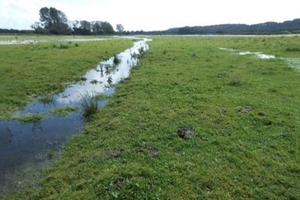 Habitat management began in autumn 2015 on our hotspot sites and is on-going through the project. This includes a variety of different works aimed at increasing lapwing and redshank productivity. Wet features, ditches and scrapes are extremely important for lapwing and redshank when raising chicks, as these habitats are rich in invertebrate food, and the soft ground facilitates feeding. In many areas, we have been removing vegetation that is blocking ditches, joining side ditches that have been separated back to the main carrier channel and re-digging ditches that have dried out completely. Scrapes have been added within fields to create chick foraging habitats away from linear features and the main river channel. Chicks are generally exposed to a larger number of potential predators if their only option is to feed at the river’s edge.
Habitat management began in autumn 2015 on our hotspot sites and is on-going through the project. This includes a variety of different works aimed at increasing lapwing and redshank productivity. Wet features, ditches and scrapes are extremely important for lapwing and redshank when raising chicks, as these habitats are rich in invertebrate food, and the soft ground facilitates feeding. In many areas, we have been removing vegetation that is blocking ditches, joining side ditches that have been separated back to the main carrier channel and re-digging ditches that have dried out completely. Scrapes have been added within fields to create chick foraging habitats away from linear features and the main river channel. Chicks are generally exposed to a larger number of potential predators if their only option is to feed at the river’s edge.
Positive signs were seen from the start, with lapwings and green sandpipers spotted on the exposed mud on one of our new scrapes, just one day after the digger left.
Field visits when the water level is high give us a good insight into the locations of low points within the fields, which naturally retain water longest. This also allows us to accurately map the locations of pre-existing ditches, which we can then reinstate. By doing this, we are restoring some of the sites to a more naturally functioning state.
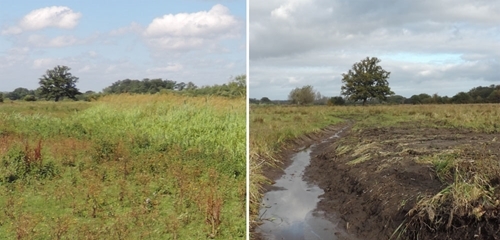
The same location before (left) and after (right) a ditch has been re-dug and vegetation cleared.
By creating more in-field wet features, we are creating more chick foraging habitat within the fields, away from linear features, which are used by several mammal predators when hunting. This also creates a more complex habitat structure, which in turn creates areas of cover for protection from avian predators and open areas for foraging.
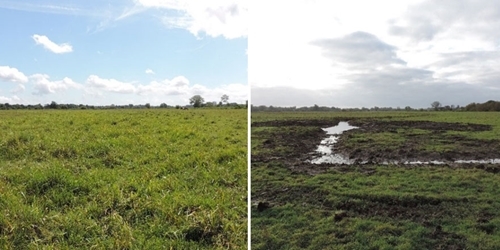
Before (left) and after (right) the creation of a shallow gutter and scrape to improve chick foraging habitat.
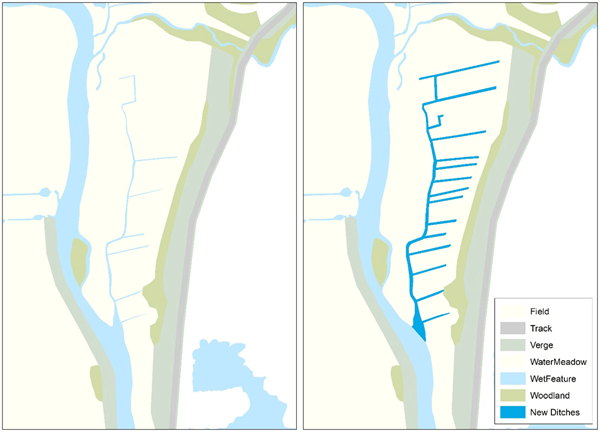
Maps of before (left) and after (right) ditch reinstatement and creation, using both existing
and relict ditch lines to create more in-field wet feature.
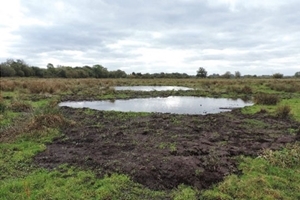
The benefit of adding large in-field pools is also be seen during the winter months for wintering snipe and jack snipe, along with wintering waterfowl such as wigeon and teal. The Avon Valley is nationally protected for its wintering wildfowl and waders. It is an extremely important area for large flocks of wigeon, teal, pintail, black-tailed godwit and many other species.
We have been working with our project partner Sparsholt College to remove old fence lines and scrub in order to open up some of the smaller fields and reduce the number of perching posts for avian predators Through this work, we are able to provide hands-on work experience for the Game and Wildlife Management students on a practical conservation project. In return, the college provides us with an enthusiastic team who are able to volunteer their time, hence reducing the costs of the management.
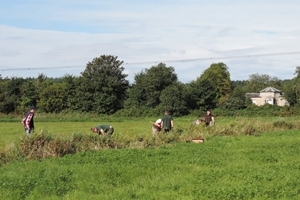
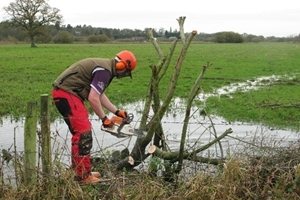
Students training for their chainsaw licence are able to get good practice taking out small alders and willows that have grown up along some of the old fence lines and ditch systems in the valley. This again opens up fields to create a more attractive habitat for larger concentrations of breeding waders. Which desire an open vista to detect incoming predators. If we can create habitats to encourage more lapwings to breed in close proximity to one another, they may be more successful at defending their nests and chicks from predators.
Please see our Useful Resources pages for guides on how to create in-field wet features